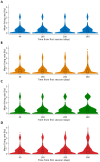A computational grid-to-place-cell transformation model indicates a synaptic driver of place cell impairment in early-stage Alzheimer's Disease
- PMID: 34133417
- PMCID: PMC8238223
- DOI: 10.1371/journal.pcbi.1009115
A computational grid-to-place-cell transformation model indicates a synaptic driver of place cell impairment in early-stage Alzheimer's Disease
Abstract
Alzheimer's Disease (AD) is characterized by progressive neurodegeneration and cognitive impairment. Synaptic dysfunction is an established early symptom, which correlates strongly with cognitive decline, and is hypothesised to mediate the diverse neuronal network abnormalities observed in AD. However, how synaptic dysfunction contributes to network pathology and cognitive impairment in AD remains elusive. Here, we present a grid-cell-to-place-cell transformation model of long-term CA1 place cell dynamics to interrogate the effect of synaptic loss on network function and environmental representation. Synapse loss modelled after experimental observations in the APP/PS1 mouse model was found to induce firing rate alterations and place cell abnormalities that have previously been observed in AD mouse models, including enlarged place fields and lower across-session stability of place fields. Our results support the hypothesis that synaptic dysfunction underlies cognitive deficits, and demonstrate how impaired environmental representation may arise in the early stages of AD. We further propose that dysfunction of excitatory and inhibitory inputs to CA1 pyramidal cells may cause distinct impairments in place cell function, namely reduced stability and place map resolution.
Conflict of interest statement
The authors have declared that no competing interests exist.
Figures







Similar articles
-
Deficits in synaptic function occur at medial perforant path-dentate granule cell synapses prior to Schaffer collateral-CA1 pyramidal cell synapses in the novel TgF344-Alzheimer's Disease Rat Model.Neurobiol Dis. 2018 Feb;110:166-179. doi: 10.1016/j.nbd.2017.11.014. Epub 2017 Dec 1. Neurobiol Dis. 2018. PMID: 29199135 Free PMC article.
-
Reduced presynaptic vesicle stores mediate cellular and network plasticity defects in an early-stage mouse model of Alzheimer's disease.Mol Neurodegener. 2019 Jan 22;14(1):7. doi: 10.1186/s13024-019-0307-7. Mol Neurodegener. 2019. PMID: 30670054 Free PMC article.
-
Alzheimer's pathology causes impaired inhibitory connections and reactivation of spatial codes during spatial navigation.Cell Rep. 2021 Apr 20;35(3):109008. doi: 10.1016/j.celrep.2021.109008. Cell Rep. 2021. PMID: 33882308 Free PMC article.
-
Hippocampal plasticity during the progression of Alzheimer's disease.Neuroscience. 2015 Nov 19;309:51-67. doi: 10.1016/j.neuroscience.2015.03.006. Epub 2015 Mar 12. Neuroscience. 2015. PMID: 25772787 Free PMC article. Review.
-
Early calcium dysregulation in Alzheimer's disease: setting the stage for synaptic dysfunction.Sci China Life Sci. 2011 Aug;54(8):752-62. doi: 10.1007/s11427-011-4205-7. Epub 2011 Jul 24. Sci China Life Sci. 2011. PMID: 21786198 Review.
Cited by
-
Grid cell modules coordination improves accuracy and reliability for spatial navigation.Cogn Neurodyn. 2025 Dec;19(1):76. doi: 10.1007/s11571-025-10263-9. Epub 2025 May 19. Cogn Neurodyn. 2025. PMID: 40401249
-
Altered synaptic plasticity at hippocampal CA1-CA3 synapses in Alzheimer's disease: integration of amyloid precursor protein intracellular domain and amyloid beta effects into computational models.Front Comput Neurosci. 2023 Dec 7;17:1305169. doi: 10.3389/fncom.2023.1305169. eCollection 2023. Front Comput Neurosci. 2023. PMID: 38130706 Free PMC article.
References
Publication types
MeSH terms
Grants and funding
LinkOut - more resources
Full Text Sources
Medical
Molecular Biology Databases
Miscellaneous

